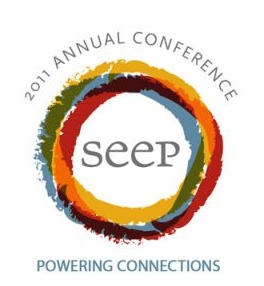2011 SEEP Annual Conference: Embracing complexity for market systems
 What do the tortilla riots in Mexico, the London riots, the global financial crisis, and Disney’s Finding Nemo have in common? As Luis Osorio of Practical Action explained, each demonstrates that markets are complex systems. Osorio, along with Marcus Jenal from Sound Systems and Tjip Walker of USAID, presented at the 2011 SEEP Annual Conference during the session titled, 'Lock and Load' without the 'Crash and Burn': Using Systems Thinking to Find the Most Effective Entry Points into a Value Chain. "If we want to be successful in our work, we need to embrace complexity,” Osorio explained. He then discussed Practical Action’s participatory market mapping. This framework lays out the interaction between the business environment, market chain, and input/service providers. He stressed that implementation is not mainly or only a technical problem, but an issue of relationships and politics, trust and power dynamics.
What do the tortilla riots in Mexico, the London riots, the global financial crisis, and Disney’s Finding Nemo have in common? As Luis Osorio of Practical Action explained, each demonstrates that markets are complex systems. Osorio, along with Marcus Jenal from Sound Systems and Tjip Walker of USAID, presented at the 2011 SEEP Annual Conference during the session titled, 'Lock and Load' without the 'Crash and Burn': Using Systems Thinking to Find the Most Effective Entry Points into a Value Chain. "If we want to be successful in our work, we need to embrace complexity,” Osorio explained. He then discussed Practical Action’s participatory market mapping. This framework lays out the interaction between the business environment, market chain, and input/service providers. He stressed that implementation is not mainly or only a technical problem, but an issue of relationships and politics, trust and power dynamics.
Marcus Jenal offered an example of an aid project that developed a system to identify “lock and load” points. The project aimed to improve the livelihoods of herders in Mongolia while reducing ecological pressures on the environment. Through collecting data and engaging with stakeholders on various levels, Sound Systems constructed an impact diagram. This web represented key factors and their relationships to each other. The team was able to identify important reinforcing loops (loops that drive the system) and dampening loops (ones that work against extremes) within the diagram. In doing so, the team targeted several variables or “entry points” and ran a series of scenarios to address the issues of city migration, limited access to markets in rural areas, and the loss of pastureland.
Jenal shared several important lessons from this project. The system dynamics analysis connects many dimensions−in this case political, market, and climate systems. And the loop analysis gives clear feedback on relationship dynamics. However, the impact diagram is a simplification of reality. The model, he stressed, is meant to “go out into reality,” be tested, and adjusted according to the feedback. This presents the need for adaptive management and flexibility on the donor side.
Tjip Walker of USAID concluded the panel discussion addressing opportunities and challenges in turning this idea into practical application. Three main opportunities he addressed were
- growing receptivity of development professionals to ideas of complexity because more and more of them had experience working in such complex and challenging environments like Iraq, Afghanistan, and South Sudan,
- growing availability of tools and practices adapted to complexity found inside and outside the development world—such as the market facilitation tools presented by Lucho and Marcus, and
- the role of technology in expanding our ability to understand and visualize complex relationships more easily.
However, incorporating the principles of complexity requires a paradigm shift from what Walker coined as an “engineering model” of development to an “experimental model” where projects are treated as experiments and learning opportunities to identify what works best in a particular environment. Making the shift to the experimental model is complicated by the familiarity donor agencies and their stakeholders have with a model and the investment they have made in planning and design models based on linear thinking and predictable outcomes. A particular challenge is redefining accountability from guaranteeing particular results to adherence to a rigorous process of learning by doing.
So what does this all mean? The panel ended with questions on moving forward to deepen and broaden the discussion. What would this new toolbox look like? How can we make a case for qualitative data? And how can we better understand the nature of learning? The recent USAID Complexity Event grappled with these issues.

